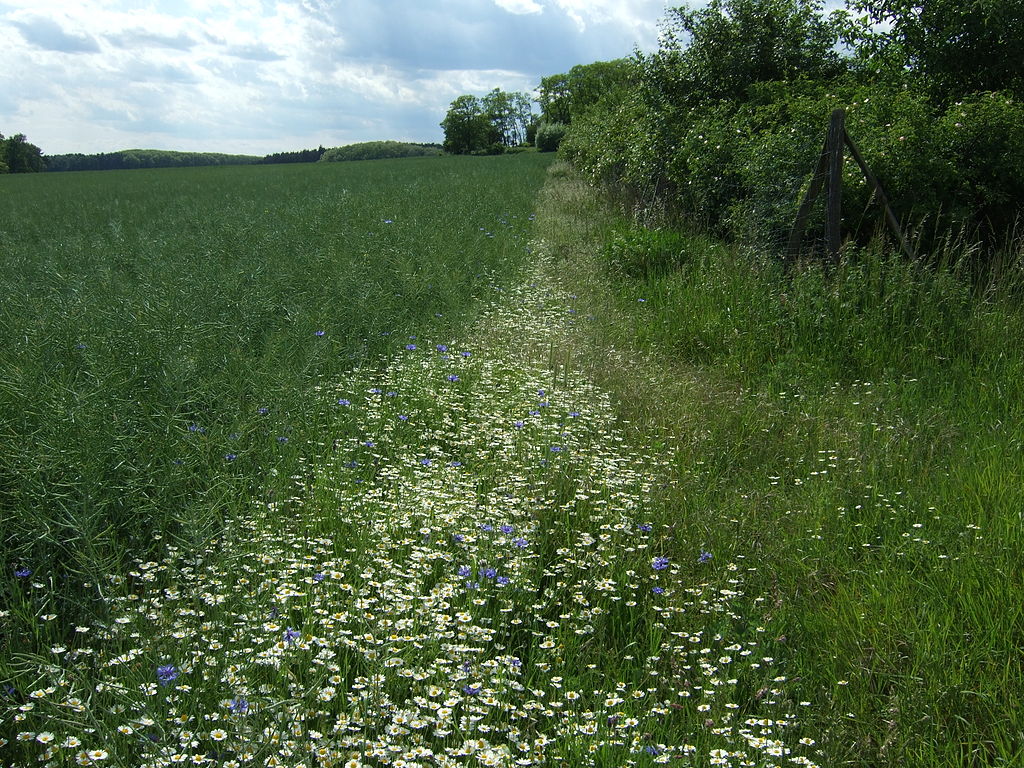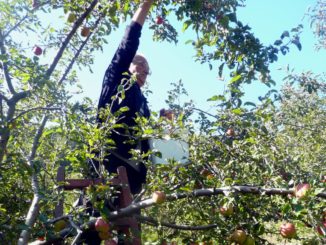Catch crops (68%), fallow land (16.2%) and nitrogen fixing crops (11.8%) dominated ecological focus areas (EFAs) in Germany in 2015. Why is this? What influences farmers’ decisions on EFAs? One of the authors of a new peer reviewed publication on this topic, ARC2020 regular Sebastian Lakner, summarises the paper, in which he and colleagues interviewed a range of experts on the matter.

To get an empirical view on motivations, we did qualitative, semi-structured telephone interviews with German agricultural experts, asking questions such as “Can you please explain farmers’ EFA decisions in your federal state based on your professional experience?”
We did not ask from a specific set of hypothesis or categories, but used an open form of question, to allow the interviewee to give their perspective. For the recommendations, we asked “Could you please give us suggestions for the improvement of biodiversity conservation within agricultural policy?” The responses were analysed by the method of qualitative content analysis. We identified three groups of experts.
(1) members of the ministries of agriculture, who were in charge of greening administration
(2) representatives of the farmers associations in the federal states and
(3) members of the institutional or private extension services, doing extension linked to greening.
We interviewed 35 experts in all German federal states, the experts gave overall 317 stated motives, which we analysed using MAXQDA. The results on the motivations show the following:
Fig. 1: Main categories of determinants explaining EFA choices by farmers as identified based on expert interviews.
(*The numbers are based on counting single-coded utterances that refer to motives used by interviewees to explain farmers’ decisions. Thus, a single interview could list several categories, as well as several references to the same category due to the sub-categorization.)

Administrative considerations. The figure highlights that “administrative considerations” (with 147 statements) have the largest influence on farmer decisions. Within this, technical complexity and a perception of risk for the farm emerged. Experts have pointed to a specific issue with area measurement of buffer strips and landscape elements: If the registered area deviates more than 20% from the measured area, farmers risk not only a penalty of 37.5% of the direct payment. In some specific cases, they can lose the premia-entitlement of this area for the next seven years.
So for good reason, farmers show little willingness to implement the complex measure, such as buffer strips (with a share of 0.6% in the EU) and landscape elements (4.3%). In practice, this means mainly the choice of ‘easy’ options such as nitrogen fixing crops (46.2%) and catch crops 27.2%, which have the largest proportion within EFA in the EU. Fallow land (21%) is also among the ‘easy options’, but at least here, ecologists see a positive contribution for the support of biodiversity, which makes fallow land interesting as ‘win-win-option’.
Overall, problems in administrative conditions are partly based on a lack of clarity in the general EU rules, but also in national implementation. The interviews were done in the first year, so this category might not be as important in future years. However, EFA-figures from Germany in 2016 show that farmers did not change their EFA-options, so even if the requirements are clearer in subsequent years, the problem will remain. This means, importantly, that motivating farmers for more ecologically effective options such as buffer strips, landscape features and fallow land is not only an information problem. From the farmers’ perspective, there is a real risk of losing significant payments through complexity-related mistakes, a risk that does not hold for simpler measures.
Economic considerations (71) are also important. Farmers compare costs and choose the options which are less costly. There is a the pure cost comparison between options, there are transaction costs and the potential risk of an EFA-option in terms of prices and yields, among other economic factors. There is also the question of which of the EFA-option fit into the established farming practices. One main example is the use of catch crops, which can be implemented at low costs and which has been already established practice before 2015.
Closely related to this, the experts state that location factors (49) such as soil, climate and topography influences the EFA-choice as the third main category. Farmers try to adjust the EFA-option to specific land conditions or farms structures, as they for example use established farming practices or landscape elements to cover parts of their obligation. We find e.g. leguminous plants in southern Germany based on the longer harvesting period or in eastern Germany, where specialised harvesting machinery are rather available. In contrast, catch crops are avoided in some past of East Germany, since it might withdraw humidity from the soils. Another example is traditional hedges (‘Knicks’) in Schleswig-Holstein, which are supported and registered to a large extent: Landscape elements contribute to 48% to the ecological focus area in Schleswig-Holstein, whereas in the rest of Germany, landscape elements make up 1-3% more typically.
Ecological considerations (26) play a minor role within the choice of EFA-options: Following the experts statement, farmers reflect on potential ecosystem services (ESS) of an EFA-option, but also on biodiversity protection and on aesthetic dimensions of landscape or opportunities for hunting. From the low number of statements, we can conclude that these topics are not of great importance in the communication between farmers and experts. This also highlights that objectives of EFA should be communicated more carefully in order to motivate farmers to make use of effective measures.
Finally, policy incentives (24) are also reflected in farmer choices: Potential combination with agri-environmental programs or overlaps and conflicts with e.g. cross compliance are taken into account for the EFA choice.
We collected a number of recommendations on how to improve EFA as a policy instrument.
1. Reduce technical and administrative complexity
2. Assure competent technical assistance
3. Increase the share of biodiversity supportive EFAs
4. Improve coordination with agri-environmental measures (AEM) to increase economic incentives for biodiversity supportive EFAs
5. Highlight additional ecosystem services provided by EFAs
6. Support sense of ownership / provide flexibility for local conditions
7. Replace EFAs with voluntary AEMs (as pillar 2 mechanism)
Within the expert recommendations, the expansion of both pillar II (33) and of agri-environmental programs emerged as dominant. There were also a number of recommendations on how to specifically improve the design of greening (13) and some more general recommendations (32). In general, this group of experts suggest that strengthening agri-environmental programs is the more efficient way to support biodiversity within the CAP. However, given the actual policy design, there are also a number of small changes that could be applied within the existing framework.
Our results document that pure socio-economic theory might not fully capture all potential motivations. Administrative considerations play a major role in this decision process. However, these motives overlap with economic considerations so administrative questions might lose importance in future years, as the interviews were done in the first year of implementation. On the other hand, the findings of this expert assessment also overlap with the results of interviews with farmers done in two MSc-Theses at University of Göttingen: Farmers also point out the importance of administrative constraints and problems within the EFA-implementation.
Finally, our study provides numerous recommendations for an improvement of EFA and of conservation policies in general. One main recommendation is to reduce technical and administrative complexity. Technical assistance, information and communication are necessary to improve awareness in the sector. It is recommended to increase the share of effective EFA-options and to improve the coordination with agri-environmental measures (AEM). Experts also recommend to improve ownership of farmers and finally replace EFA by voluntary AEM in pillar II in order to base these measures on voluntary participation. We have elaborated a Policy Brief, which shortly summarises the recommendations. Our article is open access in the journal Land Use Policy, here the motives are described with more detail and precision.
Sources
Zinngrebe, Y., G. Pe’er, S. Schüler, J. Schmitt, J. Schmidt & S. Lakner (2017): The EU’s Ecological Focus Areas – explaining farmers’ choices in Germany (Open Access!), Land Use Policy, Vol. 65 (June 2017): 93-108, doi: 10.1016/j.landusepol.2017.03.027.
NEW: Implementing EFAs policy brief
Abstract

Ecological Focus Areas (EFAs) have recently been introduced as key element in the greening of the EU’s Common Agricultural Policy. In 2015, farmers across the EU have implemented EFAs for the first time. Data for German federal states indicate a strong variance in EFA decisions with an overall dominance of catch crops, nitrogen fixing crops and fallow land – two of which bear limited benefits for biodiversity conservation. This article explores how experts explain EFA choices. We conducted 35 qualitative, semi-structured interviews with representatives from the Ministry for Agriculture, farm advisory services, and farmers’ associations in each federal state. Applying content analysis we clustered the factors mentioned as determinants for farmers’ EFA choices into the categories administrative considerations, economic considerations, local factors, ecosystem considerations and policy incentives. According to the interviewed experts, farmers have primarily registered measures that already existed on their farms. Administrative considerations dominate the identified determinants for farmers’ EFA decisions, and together with economic considerations appear to function as a negative incentive for EFA options that are beneficial for biodiversity, such as landscape elements and buffer strips. We conclude that conditions for EFA implementation were found to not effectively incentivise a higher share of biodiversity supporting characteristics in German agricultural landscapes. Based on a detailed discussion we extract recommendations on how to improve EFA implementation.
Full paper (open access) available here:
http://www.sciencedirect.com/science/article/pii/S0264837716307426
#AfterCAP | Fit, Fair & Sustainable: A new agricultural policy model for the CAP 2021





